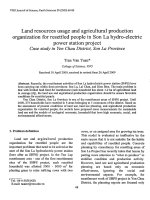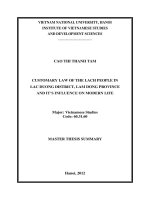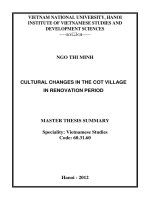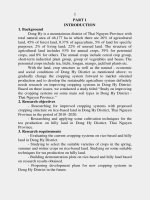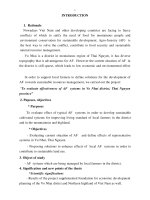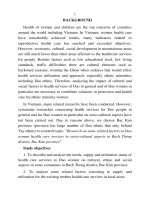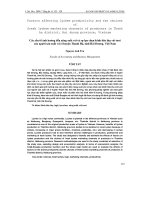Cultural changes in marriage and funeral customs of San Diu people in Phu Binh District, Thai Nguyen Province = Những biến đổi văn hóa trong phong tục cưới xin 16202420150227
Bạn đang xem bản rút gọn của tài liệu. Xem và tải ngay bản đầy đủ của tài liệu tại đây (3.29 MB, 133 trang )
1
VIETNAM NATIONAL UNIVERSITY,HA NOI
INSTITUTE OF VIETNAMESE STUDIES AND DEVELOPMENT SCIENCES
DUONG THUY LINH
CULTURAL CHANGES IN MARIAGE
AND FUNERAL CUSTOMS OF SAN DIU PEOPLE
IN PHU BINH DISTRICT, THAI NGUYEN PROVINCE
MASTER THESIS
Major: VIETNAMESE STUDIES
Hanoi – 2012
2
VIETNAM NATIONAL UNIVERSITY,HA NOI
INSTITUTE OF VIETNAMESE STUDIES AND DEVELOPMENT SCIENCES
DUONG THUY LINH
CULTURAL CHANGES IN MARIAGE
AND FUNERAL CUSTOMS OF SAN DIU PEOPLE
IN PHU BINH DISTRICT, THAI NGUYEN PROVINCE
Master thesis, major: VIETNAMESE STUDIES
Code: 60 31 60
Supervisors: Duong Thuy Linh
Associate.Prof.Dr. Hoang Luong
Hanoi - 2012
3
TABLE OF CONTENTS
TABLE OF CONTENTS 1
LIST OF TABLES 5
INTRODUCTION 6
1. Reasons for choosing this issue 6
2. Background information on this issue 8
3. Purposes, objects and scope of the research 11
3.1. Purposes of the research 11
3.2. Objects and scopes of the research 11
4. Theoretical bases and research methods 12
5. Contribution of the thesis 13
6. Layout of the thesis 13
CONTENTS 14
Chapter 1: GENERAL GEOGRAPHIC INFORMATION OF PHU BINH DISTRICT –
THAI NGUYEN PRIVINCE AND THE SAN DIU ETHNIC GROUP 14
1.1. Geographic location and natural conditions 14
1.1.1. Geographic location 14
1.1.2. Natural conditions 15
1.2. Social and economic situation 17
1.3. San Diu People in Phu Binh District - Thai Nguyen Province 21
1.3.1. The people’s name, historical origin and population 21
1.3.2. Social organization 25
1.3.3. Livelihood culture 28
1.3.4. Material culture 29
1.3.5. Spiritual culture 32
Sub - conclusion for chapter 1 35
4
Chapter 2: TRADITION AND CHANGE IN MARRIAGE CUSTOMS OF SAN DIU
PEOPLE IN PHU BINH DISTRICT, THAI NGUYEN PROVINCE 36
2.1. The concept of marriage 36
2.2.The ritual of marriage 44
2.3. Changes in marriage customs 65
Sub- conclusion of Chapter 2 75
Chapter 3: TRADITION AND CHANGE IN FUNERAL CUSTOMS OF SAN DIU
PEOPLE IN PHU BINH DISTRICT, THAI NGUYEN PROVINCE 77
3.1. The concept of human agency, worldview 77
3.2. The ritual of the funeral 80
3.3. Changes in funeral customs 93
Sub - conclusion of chapter 3 97
Chapter 4: CULTURAL VALUES IN MARRIAGE AND FUNERAL CUSTOMS OF
SAN DIU PEOPLE IN PHU BINH DISTRICT 98
THAI NGUYEN PROVINCE 98
4.1. The cultural value of traditional marriage customs 98
4.2. The cultural value of traditional funeral customs 102
4.3. Some causes of changes and solution to preserve and promote the values of marriage
and funeral customs of the San Diu people in Phu Binh district, Thai Nguyen 107
4.3.1. Causes of changes 107
4.3.2. A number of suggestions and proposals to preserve and promote the values of marriage
and funeral customs of the San Diu people in Phu Binh district, Thai Nguyen 111
Sub-conclusion of Chapter 4 118
CONCLUSION 119
REFERENCES 123
5
LIST OF TABLES
Table 1.1: Population Phu Binh district divided by ethnicity, gender, and
urban and rural areas.
Table 1.2: Population of the San Diu in Phu Binh district, Thai Nguyen
province.
Table 4.1: Comparison of changes in the role of grandparents each
wedding in San Diu - Phu Binh Thai Nguyen.
Table 4.2: The comparison table shows the changes over the years in the
wedding the San Diu - Phu Binh Thai Nguyen.
Table 4.3: The comparison table shows the change in the person's
wedding San Diu - Phu Binh - Thai Nguyen by age.
Table 4.4: The table shows a principle than inner hair San Diu some
hooks of the distance that you put - Phu Binh Thai Nguyen.
Table 4.5: Comparison table shows the change in the marriage customs of
the San Diu - Phu Binh Thai Nguyen in the Media and now
Table 4.6: Comparison table shows the change in the funeral customs of
the San Diu - Phu Binh Thai Nguyen in traditional and today.
6
INTRODUCTION
1. Reasons for choosing this issue
Vietnamese culture is the culture of “diversity in unity ". It is the
convergence of cultural values of the 54 ethnic groups living in the territory of
Vietnam. During their history and development, each group has created typical
traditional cultural values for themselves. Each ethnic group has their own
cultural values; and through history these cultural values become their cultural
identities, contributing to the multi-nuanced culture of Vietnam.
Cultural identity is one out of three criteria to determine the ethnic
structure in Vietnam. So, the existence of each group is attached with their
cultural characters. The loss of the cultural values of a nation will gradually lead
to the disappearance of that nation. Particularly, in the context of current
integration, the issue of national cultures is paid more and more attention. An
urgent need is that to integrate does not mean to dissolve the culture. We
integrate with the international trends, but still reserve our traditional national
values. National values are our cultural characters. Vietnam cultural characters
are the cultural values of every ethnic group living on the territory of Vietnam,
in particular the Kinh people and 53 ethnic minorities. The research and studies
on Vietnamese characters can not be separated from studying the cultural
characters of each of the 54 peoples in Vietnam.
Our Party and Government also attach great importance to conserving and
promoting cultural values of ethnic groups. In 1991, in the "Platform for
national construction in the period of transition to socialism" the Party has stated
to respect for the interests of cultural traditions, languages, customs and beliefs
of the peoples, and at the same time, to reserve and promote moral, ethic,
aesthetic values and the cultural and artistic heritages of every people.
7
In the huge family of Vietnam’s ethnic groups, San Diu people, also
known as Son Dzao people (Dzao people in the mountains), mainly live in the
provinces of Quang Ninh, Hai Duong, Bac Giang, Thai Nguyen, Tuyen Quang ,
Yen Bai, etc. Having immigrated to Vietnam and settled in Thai Nguyen for just
about 3 centuries, but they still reserve their available cultural values, together
with other groups’ cultures they have absorbed simultaneously, to create their
own tradition cultural characters.
It is affirmed that life cycle rites are the profound expression for ethnic
culture characters, especially spiritual, psychological life and customs of each
group. Besides, these are exceptional cultures well reserved and hardly changed
for a long time, because they themselves contain meaningful humane values,
which is ground for prosperity of every group’s culture. Every San Diu person,
from birth till death, goes though their group’s life cycle rites, which helps
building their cultural values. Studying their life cycle rites is a must if we want
to study their cultural values.
The major milestones in each person’s life are marked by following
rituals: marriage, giving birth and funeral, which are the turning points of his
(her) life. They enable development inside each person in accordance with
natural laws and under impact of social ones. The issue of studying San Diu
people’s cultures in general and the issue of explaining the changes in life cycle
rites in particular remain unsolved.
Thinking of that we decided to choose to do research on this issue
“Cultural changes in marriage and funeral customs of San Diu people in Phu
Binh District, Thai Nguyen Province” with which we aims to show significant
changes in marriage and funeral customs of the local San Diu People, firstly to
contribute to the study of cultural characters of ethnic minorities in Vietnam,
and finally to make ground for the study of Vietnamese cultural characters.
8
We hope that this research upon completion will help understanding more
of San Diu People’s culture, as well as cultures of all the ethnic groups in
Vietnam; and basing on that to propose suitable policies about preserving and
promoting cultural values of marriage and funeral customs, two of the life cycle
rites of San Diu People in Phu Binh District, Thai Nguyen Province in particular
and San Diu People all around the country in general.
2. Background information on this issue
In the last few years, the trend to study and research on traditional ethnic
cultures has become more and more popular. Although the ethnic minorities
only cover about 13% total population, each of them owns unique culture and
customs, which creates the national diversified-but-unified culture, the
progressive and well reserved culture of Vietnam.
The San Diu ethnic group in Vietnam is also an interesting issue which
has been attracting many ethnologists and writers. There has been many deep
researches done on their culture published into books or writing on magazines.
The book Nguoi San Diu o Viet Nam written by Ma Khanh Bang,
published in 1983, is an overview picture of life of San Diu people in Vietnam.
The author has researched and presented a general overview of the San Diu
people: the name, foundation and development history, as well as the social
organization, material and spiritual cultures, and their tradition customs which
make up their own cultural values. He concludes that San Diu group is a
minority who continuously absorbs other groups’ cultures, but still keeps in
mind that they are a people.
Writer Diep Trung Binh, in Phong Tuc va Nghi Le Chu Ky Doi Nguoi cua
Nguoi San Diu o Viet Nam (2005), describes in details most customs of San Diu
People during their life cycle from birth to death. Besides, he also shows his
9
opinions about their cultural values and changes in these values shown in their
life cycle rites.
In Tri Thuc Dan Gian trong Chu Ky Doi Nguoi San Diu o Viet Nam,
published by National Culture Press in 2011, Diep Trung Binh also mentions
cultural values of the San Diu people through their folk knowledge in giving
birth, raising children, growing up, marriage and funeral.
He also collects, studies and translates San Diu people’s folk songs in
their everyday life and corresponding singing in weddings. All is published in
the book Dan Ca San Diu by National Culture Press in 1987.
The book “Cac Dan Toc It Nguoi o Viet Nam (Cac Tinh Phia Bac)”also
gives a general overview of the San Diu people in Vietnam. The authors briefly
describe history of the people and the living cultures, including material cultures
in their houses, costumes, food, and spiritual cultures in their rituals like
marriage and funeral, etc.
“Dan Toc San Diu o Bac Giang”, written by Ngo Van Tru and Nguyen
Xuan Can (main editor), by National Culture Press, Hanoi, 2003, is a full picture
of San Diu people in Bac Giang, presenting in details from history, name, living
territory, etc., to traditional economic activities, food, traditional costumes,
rituals and customs related to life cycle.
The author Nguyen Ngoc Thanh, in his book “Van Hoa Truyen Thong
San Diu o Tuyen Quang”, published in 2011, also gives the most general
overview of the history of this people, as well as their residence and cultural
identities in Tuyen Quang Province.
These above mentioned researches provide a useful theoretical ground
and comparative object for me to objectively study the cultural changes of the
San Diu minority in Phu Binh through their customs of marriage and funeral.
10
Dr. Nguyen Thi Que Loan has deeply studied the eating habits of the
people, and reflected the result in her doctorial thesis “Tap Quan An Uong cua
Nguoi San Diu o Thai Nguyen”. This thesis discusses in details about the
traditional sources of their foods, their traditional methods of preparing foods
and drinks, as well as changes of these customs when the people exchange and
learn from other groups.
Related to the above issue, Dr. Nguyen Thi Que Loan also wrote a post on
the Ethnology Magazine, “Bien Doi Trong Tap Quan An Uong cua Nguoi San
Diu Tinh Thai Nguyen”.
Researcher Le Minh Chinh had a study on San Diu People in Thai
Nguyen majoring in medical aspect called “Thuc Trang Thieu Mau o Phu Nu
San Diu Trong Thoi Ky Mang Thai tai Huyen Dong Hy Tinh Thai Nguyen va
Hieu Qua cua Bien Phap Can Thiep”.
Dam Thi Uyen and Nguyen Thi Hai wrote “Tin Nguong Cu Tru Cua
Nguoi San Diu o Thai Nguyen” on the Nation and Times Magazine, number 89,
2006. The post mentioned their social organization and spiritual views in their
residing customs.
Also on the Nation and Times Magazine, number 87, 2006 there was a
post by Nguyen Thi Mai, titled “Le Hoi Cau Mua cua Nguoi San Diu”, showing
us about the people’s spiritual viewpoints in season and weather.
The ethnologist Chu Thai Son wrote the book “Dan Toc San Diu”,
published by Kim Dong Press in 2011, to supply for the programme “Books
supplied by the States for the children in remote or mountainous area”. It briefly
introduce San Diu minority group in Vietnam in aspects of history, working and
living habits, traditional customs, mental life and present living conditions.
The above mentioned works reflect a long history of studying San Diu
people’s culture in Vietnam in general and in each area in detailed. However,
11
researching on culture of San Diu group in Phu Binh - Thai Nguyen in general
and studying the cultural changes in their marriage and funeral customs in
particular are still mostly left unattended. Thus, the above mentioned works will
help me a lot in my studying and clarifying the cultural changes in the marriage
and funeral customs of San Diu group in Phu Binh - Thai Nguyen.
3. Purposes, objects and scope of the research
3.1. Purposes of the research
This thesis “Cultural changes in marriage and funeral customs of San
Diu people in Phu Binh District, Thai Nguyen Province” aims to research and
learn how the cultural values of San Diu group in Phu Binh District, Thai
Nguyen Province are reflected in some life cycle rites, basing on which to
propose suitable policies about preserving and promoting traditional cultural
values of San Diu ethnic group in Vietnam in general, and in the researched area
in particular.
- Marriage customs and funeral rituals are related to people’s viewpoints
on their spirit, universe and life. Thus, researching on changes of these fields is
an approach to San Diu people’s viewpoints on marriage and funeral.
- Researching on changes in marriage and funeral customs in their life
cycle rites plays an important role in building the local cultural life. Thanks to
this, some proposals to promote good cultural values and to remove existing bad
rituals from their spiritual life.
3.2. Objects and scopes of the research
- Objects of the research are major changes in marriage and funeral
customs of San Diu ethnic minority in Phu Binh District, Thai Nguyen Province,
and the causes of these changes. The research bases on the comparison of the
present customs with the ones in the past, through which the cultural values in
12
their rituals and their relationship, among family members and among the public
are clearly exposed.
- Scopes of the research:
In term of space: The research is done in Phu Binh District, Thai Nguyen
Province, with a focus on the two communes Ban Dat and Tan Khanh, where
there is the highest density of San Diu ethnic people.
In term of time: The research on cultural characteristics of San Diu ethnic
group in Phu Binh District, Thai Nguyen Province from the past to present in the
comparative approach.
4. Theoretical bases and research methods
- Theoretical bases
The thesis is written basing on the dialectical and historical materialist
perspectives of Marxism - Leninism, Ho Chi Minh Thoughts, and perspectives
of our States and Party on the issues of ethnic groups and their cultures.
Accordingly, the research always approaches to the materials and phenomena in
their constant movements in space and time.
This thesis also inherits the research achievements, theoretical bases and
methodology of the local ethnologists.
- Research methods
The most important method is ethnographic fieldwork survey, in which
direct interviews with individuals and groups are made, and, at the same time,
observing, writing, video and sound recordings are realized in the two
mentioned communes (Tan Khanh and Ban Dat) of Phu Binh District. Besides,
13
other used methods are document studying, interdisciplinary method combining
ethnology, cultural study, history, sociology, comparison, contrast, etc.
- Material resource
In order to complete this thesis, we have gathered information from
different sources: survey, ethnographic field trips; talking with ethnologists;
studying documents, articles, and other press about the San Diu group, their life
cycle rites and other groups’ in Vietnam.
5. Contribution of the thesis
- To contribute to the source of field trip survey, through which we clearly
see the changes in marriage and funeral customs of San Diu ethnic group in Phu
Binh District, Thai Nguyen Province from the past to present.
- To make a systematic research in details on the two important existing
customs in life cycle rites of San Diu ethnic group in Phu Binh District, Thai
Nguyen Province, and the changes in each field through time.
- To help studying and preserving good traditional cultural values of San
Diu ethnic group in Vietnam in general and in Phu Binh District, Thai Nguyen
Province in particular.
- The research result will help building a scientific basis for cultural,
educational and social policies, in which an essential is preserving the good
traditional cultural values, and discontinuing the pessimistic and costly rituals
which limit the development of people’s awareness and society. This is
importantly related to building a new cultural living style in the public in the
period of national industrialization and modernization.
6. Layout of the thesis
Besides the Introduction and Conclusion, the thesis includes three
chapters:
Chapter 1: General geographic information of Phu Binh district - Thai
Nguyen province and the San Diu ethnic group.
14
Chapter 2: Tradition and change in marriage customs of San Diu people in
Phu Binh district, Thai Nguyen province.
Chapter 3: Tradition and change in funeral customs of San Diu people in
Phu Binh district, Thai Nguyen province.
Chapter 4: Cutural values in in marriage and funeral customs of San Diu
people in Phu Binh district, Thai Nguyen province.
CONTENTS
Chapter 1: GENERAL GEOGRAPHIC INFORMATION OF PHU BINH
DISTRICT – THAI NGUYEN PRIVINCE AND THE SAN DIU ETHNIC
GROUP
1.1. Geographic location and natural conditions
1.1.1. Geographic location
In Ly Dynasty, the nowadays Phu Binh District was called Tu Nong
District, Thai Nguyen Territory (Chau Thai Nguyen). In Minh Dynasty it was in
Thai Nguyen District (Phu Thai Nguyen). In Le Dynasty, it was in Thai Nguyen
Province (Thai Nguyen thua tuyen), which was then renamed into Ninh Soc
(Ninh Soc thua tuyen).
At the beginning of the 20
th
century, the French governor general in
Indochina renamed it into Phu Binh District (phu Phu Binh).
At the time right before the August 1945 Revolutionary, Phu Binh District
(phu Phu Binh) consisting 9 towns, 47 communes, 7 villages and 1 ward, was
one of the 7 districts (phu, huyen, chau) of Thai Nguyen Province.
March 25
th
, 1948, the government of the Democratic Republic of Vietnam
issued the Decree 148/SL about removing the terms “phu”, “chau”, “quan” from
provincial administrative naming, and using the only term “huyen” for the
division which is larger than a commune and smaller than a province. From that
15
time on, it has been officially called Phu Binh District
1
(huyen Phu Binh) [21, p.
6].
Today Phu Binh District consists of 21 administrative divisions including
20 communes and 1 town (Tan Khanh, Ha Chau, Tan Hoa, Dong Lien, Luong
Phu, Duong Thanh, Tan Thanh, Bao Ly, Nha Long, Tan Kim, Dao Xa, Tan Duc,
Xuan Phuong, Thanh Ninh, Kha Son, Uc Ky, Ban Dat, Diem Thuy, Nga My,
Thuong Dinh and Huong Son Town) which are divided into 315 villages and 4
community groups. Phu Binh District has 7 communes recognized as
mountainous ones.
Phu Binh District was in between the northern latitudes 21
0
23' and 21
0
35',
eastern longitudes 105
0
51' and 106
0
02'.
It borders Dong Hy District to the North and Northwest, Pho Yen District
and Thai Nguyen City to the Southwest and West, Yen The District (Bac Giang
Province) to the East, and Hiep Hoa District (Bac Giang) to the South.
Phu Binh District is the farthest southern point of Thai Nguyen Province.
It is not far from Thai Nguyen City (28 kilometers from district center to city
center), Gang Thep industrial zone, Hanoi Capital, and conveniently located on
the national traffic roads, so it is very easy and quick for its market economy and
the social and economic exchanges with these centers to develop, which is an
important ground advantage for Phu Binh District to move forward rapidly and
firmly in the time of industrialization and modernization in this 21
st
century.
1.1.2. Natural conditions
Total area of the district is 249.36 km
2
in which the largest section is used
for agricultural purposes: 13,845.93 ha (55.52% total area) [30, p. 1].
- Topography: the average gradient of about 0.04% decreases from
Northeast to Southwest; the average height difference is 14m, the lowest one of
16
10m is in Duong Thanh Commune. The highest peak is on Bop Pass at 250m
high above sea level.
In general its topographic features include being comparatively flat with
some low and slightly sloping downward-bow-shaped hills of 100 meters high at
most. The area with sloping degree lower than 8
0
is majority (67.56% total area),
which is an advantage for developing agriculture, especially growing food crops.
- Climate and hydrology: Locating under the Tropic of Cancer, Phu Binh
District owns the monsoon tropical climate (Phu Binh District is in the hot area
of the province). Besides, as its location is in the Northeast Vietnam, it features
the typical climate of this area where the monsoon can easily be caught.
+ The annual average temperature is 23.1
0
C - 24.4
0
C; the difference
between the hottest and the coldest months is 13.7
0
C.
+ The annual average rainfall is 2000-5000 mm; the highest rainfall is on
August and the lowest in January.
+ The annual total time of sunlight is about 1206-1570 hours.
+ The annual average humidity is 81-82%.
+ Winds: in Summer Southeast breeze is prevailing; but in Winter with
the Northeast monsoon, the weather is cold and dry, causing great troubles for
people’s working.
The fact that Phu Binh District is in warm climate area is an advantage for
agriculture, forestry, and local residents’ life. It enables the development of a
stable diverse ecosystem in general, and agriculture and forestry in particular.
- River system: Phu Binh District has the rich water supply of two rivers
and three small streams.
17
The Cau River, a river in the system of Thai Binh rivers, derives in Cho
Don District - Bac Kan Province. It runs through several districts such as Bach
Thong, Phu Luong, Vo Nhai, then runs in northwest - southeast direction to Thai
Nguyen City, Phu Binh District, Pho Yen District and Bac Giang Province. Its
part in Phu Binh District is 29 kilometers long, starting from Thac Huong Dam
(Dong Lien Commune), running through 9 other communes and finally entering
Pho Yen District in Cha Commune. The average width of the river is 120 meter.
This river is a quite convenient waterway and a rich source of water for farming.
The Dao River (also known as Mang River) which derives from Thac
Huong Dam (Dong Lien Commune) runs through nine communes with the total
length of 31 kilometers before entering Bac Giang Province and joining the
Thuong River. This river is an important part of the huge irrigation system
supplying water for 1800 hectares of farms in Phu Binh District and thousands
of farms in Hiep Hoa, Tan Yen and Yen The Districts - Bac Giang Province.
Phu Binh District also has three main small streams deriving from
northeast area running through Ban Dat, Dao Xa, Tan Khanh, Tan Kim and Tan
Thanh Communes and falling into the Cau River.
Such river system has made it much easier to develop farming in Phu
Binh District.
1.2. Social and economic situation
* Economy:
Local residents in Phu Binh District mainly live on agriculture. The
farming land area is 13,845.93 hectares of which 10,085.14 hectares is used for
annual plants, 2,296.55 hectares for gardens, 1,060.43 hectares for perennial
trees [32, p.1, 2]. With such a potential and hard-working people with rich
producing experience, Phu Binh District has the right conditions for agricultural
development. In addition to food crops, vegetables, Phu Binh District also has
18
400.8 hectares of water surface for aquaculture. Although agriculture still faces
much troubles, and depends on the nature, Phu Binh District has been
considered to be a granary, a rich labor force and a rich natural resource of Thai
Nguyen Province.
Besides agriculture, in Phu Binh District there are many handicrafts,
especially pottery making in Lang Ta Village, and rattan knitting in many
villages in Diem Thuy, Thuong Dinh communes, etc.
Because its location and transportation are convenient for exchange of
goods, especially for supplying foods for markets of Thai Nguyen, Bac Giang,
Bac Ninh and Hanoi, so commerce plays an important role in the local economy.
Phu Binh District has some big markets near main roads such as Don Market,
Cau Market, Tan Duc Market, Hanh Market, etc., which are the exchanging
points for nearby regions. Huong Son Town is more and more widen and
crowded, attracted a large number of residents coming to open their businesses.
Phu Binh people and Cell of Communist Party have well performed the
reforms initiated and led by Vietnam Communist Party (1986) through the Party
Congresses (from the Ninth Congress (1986) to the Fourteenth Congress (2005-
2010)) and obtained great achievements in every fields and gradually made right
use of local potentials. In 2011, although Phu Binh District people and
government faced the same difficult challenges as other parts of the country,
they have gained significant results in realizing socio-economic development
tasks, such as:
Economic growth rate (GDP) in the area is estimated at 11.5%.
Per capita income is estimated at 13 million dongs/person/ year.
Production of agriculture, forestry, and fisheries in 2011 increased by
3.9% (especially farming production increased by 5.2% (thanks to the two
successful rice crops, the most productive crops ever before, other crops quite
19
stable and favorable). Total grain output of the whole year was 75,877 tons, an
increase of 3.7% over 2010.
Total state budget revenue in the area was estimated at 48.5 billion dongs.
The production value of industry and small-scale industry (at constant
price of 1994) was estimated at 75 billion dongs.
Meat finisher output was 17,000 tons, increasing 6.25% over 2010.
The district forest area was 351 hectares, an increase of 56.5% over 2010.
The production value per 1 hectare of farming land (present price) was
estimated at 67 million dongs, increasing 9 million over the plan.
Forest coverage rate reached 25%.
* Society:
According to the preliminary population census of Phu Binh District, as
on April 1
st
, 2009 its total population is 133,322 people in 34,963 households, of
which the rural population is 125,887 people, and urban population is 7435
people. The average population density is 556 people per square kilometer,
coming second after Thai Nguyen City.
Besides land and natural resources, the potential in labor force of Phu
Binh District is noteworthy.
In 2011, Phu Binh District has created new jobs for 3,100 employees,
equally 103% of plan targets, of which 130 people are sent to work abroad under
predefined period, equally 108.3% of the plan of the year; District vocational
training center provided training and associated training for over 702 people,
equally 140% of the plan, 96.8% of which have been employed immediately
after being trained.
The crude birth rate has been reduced to 0.3‰ (estimated) which is 0.1‰
lower than planned.
20
The poor household rate has been reduced to 5.07% (estimated) which is
2,07% lower than planned.
Material and spiritual life of the local people of all groups has been
significantly improved; many social policies to support ethnic minorities, the
poor and disadvantaged areas have been seriously implemented. The policies of
the Party and State have been realized comprehensively, timely and effectively.
The district has 21 kindergartens, 21 primary schools and 21 secondary
schools, 03 high schools, 01 continuing education center, 01 career consulting
center, 01 vocational training center; all communes or town have their own
community learning centers. So far the district has completely removed
illiteracy, completed popular secondary school education and has had 25 schools
having achieved the National Standard. The schools and their facilities have
been solidly built.
Health care for people: District Hospital continues to be invested in
infrastructure and facilities; 100 percents of commune health centers have
doctors with their facilities, medical instruments being enhanced; population and
family planning propaganda co-operators and village physicians are available in
most of the villages and town’s population groups. Therefore, basic health care
needs have been met.
The percentage of malnourished children under 5 years old has been
reduced to 21.4%.
The percentage of rural households using hygienic water is 75%.
Social security and the local army training have been well organized, met
100% of the targets.
Infrastructures: the traffic system has received great interest and
investment; the project of renovating and upgrading Highway 37 has been
completed; many inter-communal roads have been invested to widen and asphalt
21
such as Cau May - Tan Kim - Tan Khach Road, Cau May- Dong Lien Road, Uc
Son - Tan Thanh - Hop Tien Road, and many others are under plans to be built
in the short coming time. Facilities for schools, classes, hospitals, and clinics
have been being well invested. All villages have been provided with national
electricity to use in daily life and production. These are favorable conditions to
evoke potentials and strengths, to boost the economy of the mountainous areas
with large ethnic minorities.
Road system of Phu Binh District is relatively dense. Highway 37 from
Thai Nguyen City runs through the entire length of the district to Bac Giang.
National Highway 38 from Diem Thuy via Ha Chau and Kha Son to Nha Nam
(Bac Giang). In addition to the two main highways, Phu Binh also has 120
kilometers of inter-communal, 198 kilometers of inter-village roads, enabling
car drive in every village in the district.
Social security situation: the political security and social safety in the
district is always stable; all ethnic minorities in the district absolutely believe in
the leadership of the Party and local authorities. The communes of Tan Khanh,
Tan Hoa, Tan Kim, Ban Dat and Dong Lien have done good work in keeping
security in the border areas over the years.
1.3. San Diu People in Phu Binh District - Thai Nguyen Province
1.3.1. The people’s name, historical origin and population
In Vietnam San Diu people is a minority group with small population,
living mainly in the North: about 40,000 people, living on some low hills of the
Quang Ninh, Hung Yen, Bac Giang, Bac Ninh, Phu Tho, Vinh Phuc, Bac Kan,
Thai Nguyen, Ha Giang, Tuyen Quang, and Thanh Hoa [31, p. 396].
San Diu people call themselves “San Deo Nhin”, Sino-Vietnamese
transcription is “Son Dzao Nhan” which means Dzao People on the hills. Other
peoples call San Diu people with different names basing on their dressing style,
22
their house style, etc., such as: Man Quan Coc or Trai Coc (people with short
pans), Man Vay Xe (people with slit skirts), Trai Dat, etc.
Not until Mar 1960 the name San Diu was officially recognized by the
National Department of Statistics. From that time on, the name San Diu has
been officially used in all administrative documents. Nowadays, the name San
Diu is popularly used around the country.
The origin of San Diu people has not been revealed, as there is no
historical evidence about that; and all we have is by guess.
Although their origin has not been determined, San Diu people are always
aware of being a people with the name San Diu they called themselves. No one
remembers how they migrated to Vietnam; only the pain and frightening are left
in their mind. However, they still clearly remember when they joined the
Vietnamese peoples to live here.
In his book “ San Diu people in Vietnam”, Ma Khanh Bang wrote: “After
entering Vietnam, San Diu people crossed over Hoang Chuc Cao Son Mountain
to Ha Coi, Tien Yen before spreading to many other places. Some of them went
along the coastline to Dam Ha, Mong Cai, Hoanh Bo, Mao Khe, Dong Trieu
and a small number went to Chi Linh (Hai Duong), whereas most of them
followed the Yen Tu Range to Luc Nam, Luc Ngan, Lang Giang, Yen The (Bac
Giang), and then from there moved to Vinh Yen, Phuc Yen (Vinh Phuc), Tuyen
Quang (Ha Tuyen), Thai Nguyen (Bac Thai). So, San Diu people have been
residing on the large midland from the left bank of Red River to the East of the
Northern Vietnam. Besides a number of residents gathering in some communes
of the former Bac Giang Province, the majority live in the Northeast and
Southeast sides of Tam Dao Range in nowadays Vinh Phu, Ha Tuyen and Bac
Thai provinces”[16, p. 22].
23
In Phu Binh District there are many peoples residing together such as:
Chinese, Nung, San Chay, Dzao, H’mong, etc. The population of Phu Binh
District - Thai Nguyen Province was 134,150 people according to statistic of the
01/04/2009 census, in which San Diu people’s population was 3115, accounting
for 2.3% of the district population.
Table 1.1: Phu Binh District’s population by ethnicity, gender, urban and
rural area
Ethnicity
Total
Urban
Rural
Total
%
Male
Female
Total
Male
Female
Total
Male
Female
Total
134150
66259
67892
7394
3617
3777
126756
62642
64114
Peoples
1.Kinh
124182
92.57
61208
62974
7202
3531
3671
116980
57677
59303
2.Tay
1804
1.34
962
842
61
33
28
1743
929
814
3.Nung
4594
3.42
2361
2233
108
44
64
4486
2317
2169
4.San Diu
3115
2.32
1521
1594
7
1
6
3108
1520
1588
5.San
Chay
19
0.01
3
16
2
0
2
17
3
14
6.Dzao
103
0.08
29
74
3
1
2
100
28
72
7.H’mong
24
0.02
15
9
0
0
0
24
15
9
8.Chinese
207
0.15
123
84
0
0
0
207
123
84
9.Other
102
0.08
37
65
11
7
4
91
30
61
Source: [26, p.119]
In Phu Binh District - Thai Nguyen Province, San Diu people are present in
mostly every commune, but the majority of them are in the two communes of Ban
24
Dat and Tan Khanh, which, respectively, count for 81 percents and 11.7 percents
of their total population of the district. Despite the scattered distribution in several
communes of the district, their culture is identical. Thus, our real research has
been carried out in reality in these two communes where there are most San Diu
people of the district in order to generalize the cultural identities available in the
two ceremonies of marriage and funeral, and comparing with traditional customs
to find the changes and reasons for those changes in today customs.
Table 1.2: San Diu people’s population in Phu Binh District - Thai Nguyen
No
Commune
Number of
households
(household)
Total
population
(person)
San Diu
population
(person)
1
Dong Lien
1104
4569
32
2
Ban Dat
1431
6194
2224
3
Tan Khanh
1789
7372
322
4
Tan Kim
1774
7646
21
5
Tan Thanh
1293
5472
5
6
Tan Hoa
1962
8289
8
7
Tan Duc
2065
8651
11
8
Uc ky
1318
5586
27
9
Xuan Phuong
1835
7761
3
10
Kha Son
2049
7747
4
11
Luong Phu
1078
4001
9
12
Bao Ly
1575
6540
33
13
Diem Thuy
1924
7215
6
14
Duong Thanh
1614
6549
7
15
Nha Long
1792
7432
1
25
16
Thanh Ninh
1235
4410
6
17
Ha Chau
1358
2538
2
18
Thuong Dinh
2104
8509
6
19
Nga My
2330
9672
3
20
Huong Son
2170
7751
7
21
Dao Xa
1,433
5,198
8
Total
35.233
139.102
2.745
Source: Results from survey on ethnic minorities in Phu Binh District of the
Chamber of Ethnicity, Phu Binh District People’s Committee, 2011.
1.3.2. Social organization
Neighborhood relationship
Them into clusters, private neighborhood, compound mixed with Chinese,
Kinh and Tay, Nung in social [31, tr. 396].
In Phu Binh District, the San Diu people’s villages are set on flat ground,
the small valley or foot of the low hills and subject to the following specific
criteria:
Firstly, its back should lie on a hill or high ridge and its front should be
flat and airy. With San Diu people, besides natural reasons, their selection of
location is also affected by Chinese geomancy. Living in the midland, lying
back on the hills and looking over the valley, they can cultivate both wet land
and dry land, as well as take advantage of natural resources provided by forests.
Furthermore, according to feng shui, at least each village or house needs a stand
to lean on. In better case, there are two “hands” on sides, and a “block” on the
far front (all are hills or ridges), that location is the best and the people living
there can thrive well.
Secondly, it should be near natural water sources (rivers, streams, creeks,
ponds), which is convenient for their living and farming. In the past, San Diu
